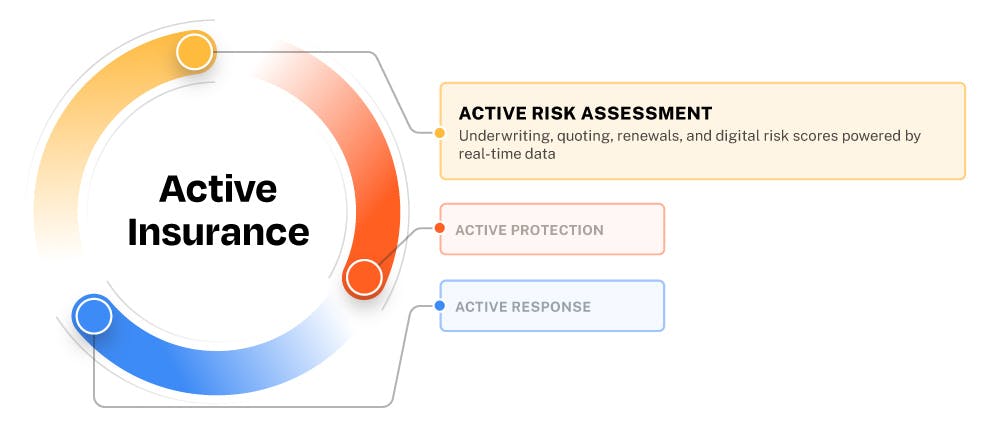Empowering Brokers with Active Risk Assessment

As the world’s first Active Insurance company, Coalition aims to help all businesses safely embrace technology in the digital economy. Our coverage model is designed to continuously identify, prevent, and resolve digital risks before they strike. We accomplish this through an integrated process that begins with an Active Risk Assessment — then providing Active Protection and Active Response (should an incident occur). This article is the first in a four-part series explaining these three key elements of Active Insurance.
Unprecedented digital convenience, access, and efficiencies are key to life in 2022 - but they also usher in increased cyberthreats. Not only did cyber claims costs increase 56% to an average of $149,000 for small businesses last year, but the average ransom demand made to Coalition policyholders rose to more than 20% to $1.8 million. With nearly 65% of the global gross domestic product to be digitized by the end of 2022[1], all organizations are at heightened risk for cyberattacks. Traditional risk management and business insurance is typically reactive and not best suited for fast-evolving digital risks. Enter: Coalition’s Active Risk Assessment, a pillar of our Active Insurance solution. Active Risk Assessment near-real-time reports reveal an organization’s digital risk exposures and vulnerabilities. For brokers, the reports shorten lengthy questionnaires and improve accuracy in underwriting cyber and executive risks — while cutting quoting process time in half.

Active Risk Assessment is a great tool for brokers
Coalition’s active approach to underwriting significantly improves the broker experience. We use our data expertise to remove uncertainty and the time-consuming work from the quoting and renewal process.
Coalition Active Risk Assessments:
1. Simplify the quoting process. When brokers submit a quote, Coalition runs an active scan of that organization to produce a personalized risk assessment. This assessment goes deeper than any questionnaire, looking at the entire supply chain of technology that might affect a policyholder’s operations.
For brokers, this reduces the tedious process of collecting technical information from clients to a few short questions. We’re able to eliminate numerous questions because of our scanning capability — which can identify everything from a company’s industry to the number of machines it has connected to the web to malware or infections in place.
2. Accelerate and optimize pricing. We use the risk scoring in this assessment to optimize pricing for any individual organization. This allows us to accurately price risk based on what’s happening — right now, inside of an organization — instead of relying on data from a week, month, or even year ago.
3. Enhance broker expertise. We also make these details available to the broker to guide their policyholder through digital risk and coverage. Coalition offers tools, knowledge, and live help to ensure you’re prepared for policyholder needs.
In addition to these personalized risk assessments, Coalition also provides brokers with additional resources to improve their proficiency and quality of service. These include Coalition's in-depth digital knowledge center, coverage comparisons, online customer service, our Security Support Center (for helping policyholders understand their cyber vulnerabilities and remediation options when responding to critical alerts), as well as monthly webinars and other training opportunities.
What is an Active Risk Assessment?
Using our Active Risk Platform, Coalition scans our policyholders externally — just like a hacker would. We also continuously monitor the dark web to measure an organization’s risk based on what vulnerabilities we identify as applicable to the systems and software they employ. Using this data, we enumerate an organization's digital footprint, compare it to our proprietary incident response and claims data, and analyze the data to create a personalized risk score. By actively scanning the cybersphere, Coalition collects all risk-related data and provides brokers with the insights on underwriting criteria needed to evaluate an organization’s real risk. With Active Risk Assessment’s powerful data capabilities, brokers are provided a near real-time snapshot of an organization’s digital risks — enabling an expedited quoting process, more accurate pricing, and the ability to identify potential issues that most traditional insurers would not be aware of.
In today’s complex corporate and environment, cybersecurity threats are not the only risks that businesses are exposed to. As another significant value add, Coalition’s Risk Assessment for Executive Risks provides brokers with key recommendations and guidance to help clients reduce their risk exposure around five specific risk exposures that may impact an organization:
Financial risk
Employee sentiment
Paycheck protection program loans
Regulatory issues
Investors
With a more accurate portrait of the company’s current financial profile, brokers can get more insight into a business’ D&O risk. As brokers know, financial issues can quickly lead to claims for decisions made by the directors and officers.
With the Active Risk Assessment’s ability to track and compile data such as social media mentions and online reviews, brokers can help guide clients on specific ways to improve. For example, reviews may show a need to increase diversity and inclusion efforts, or employee wellbeing and safety policies. Coalition has free training, tools and resources available to help clients as they make such improvements.
Coalition also assesses the investor profile, providing brokers more insight into mergers, acquisitions and funding sources. These changes are particularly important to know about during the policy period — something Coalition will notify brokers and policyholders of when we become aware of it — as these types of changes may affect coverage going forward (e.g., by potentially triggering the change in control provision).
For more insights and information on Active Risk Assessment, download our Broker's Guide to Active Insurance today.







